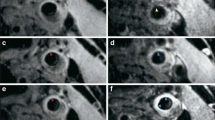Abstract
It has been shown that ED-B fibronectin (ED-B) is a potential target for plaque imaging. The aim of this study was to test a novel modified single chain anti-ED-B antibody (scFv) conjugated for near infrared fluorescence imaging (NIRF) with tetrasulfonated carbocyanine-maleimide (TSC-scFv) and to examine the association of ED-B with the presence of macrophages in a murine model of atherosclerosis. Expression of ED-B was observed in plaque areas in apolipoprotein E–deficient (apoE–/–) mice which increased with age and plaque load. Robust imaging was possible after explantation of the aorta and demonstrated a strong NIRF signal intensity in focal aortic and brachiocephalic plaque lesions, whereas no signals were found in undiseased areas. Plaque lesion ED-B was expressed by smooth muscle cell and was closely associated to macrophage infiltrates. Although not expressed by the same cell type, there was a significant correlation (p<0.01) between ED-B and macrophage immunoreactivity. In vitro human coronary and mouse smooth muscle cells significantly increased ED-B expression after angiotensin II and TNF-α treatment.This study demonstrates that plaque NIRF imaging is feasible with a novel single chain antibody and that ED-B expression is closely associated with inflammation in experimental atherosclerosis.
Similar content being viewed by others
References
Blaschke F, Stawowy P, Kappert K, Goetze S, Kintscher U,Wollert-Wulf B, Fleck E, Graf K (2002) Angiotensin IIaugmented migration of VSMCs towards PDGF-BB involves Pyk2 and ERK 1/2 activation. Basic Res Cardiol 97:334–342
Botnar RM, Perez AS,Witte S,Wiethoff AJ, Laredo J, Hamilton J, Quist W, Parsons EC Jr, Vaidya A, Kolodziej A, Barrett JA, Graham PB, Weisskoff RM, Manning WJ, Johnstone MT (2004) In vivo molecular imaging of acute and subacute thrombosis using a fibrinbinding magnetic resonance imaging contrast agent. Circulation 109:2023–2029
Bruemmer D, Collins AR, Noh G,Wang W, Territo M, Arias-Magallona S, Fishbein MC, Blaschke F, Kintscher U, Graf K, Law RE, Hsueh WA (2003) Angiotensin II-accelerated atherosclerosis and aneurysm formation is attenuated in osteopontin-deficient mice. J Clin Invest 112:1318–1331
Bruemmer D, Riggers U, Holzmeister J, Grill M, Lippek F, Settmacher U,Regitz- Zagrosek V, Fleck E, Graf K (2001) Expression of CD40 in vascular smooth muscle cells and macrophages is associated with early development of human atherosclerotic lesions. Am J Cardiol 87:21–27
Deguchi JO, Aikawa M, Tung CH, Aikawa E, Kim DE, Ntziachristos V, Weissleder R, Libby P (2006) Inflammation in atherosclerosis: visualizing matrix metalloproteinase action in macrophages in vivo. Circulation 114:55–62
Dubin D, Peters JH, Brown LF, Logan B, Kent KC, Berse B, Berven S, Cercek B, Sharifi BG,Pratt RE et al. (1995) Balloon catheterization induced arterial expression of embryonic fibronectins. Arterioscler Thromb Vasc Biol 15:1958–1967
Glukhova MA, Frid MG, Shekhonin BV, Balabanov YV, Koteliansky VE (1990) Expression of fibronectin variants in vascular and visceral smooth muscle cells in development. Dev Biol 141:193–202
Haller H, Quass P, Lindschau C, Luft FC, Distler A (1994) Platelet-derived growth factor and angiotensin II induce different spatial distribution of protein kinase C-alpha and -beta in vascular smooth muscle cells. Hypertension 23:848–852
Kappert K, Blaschke F, Meehan WP, Kawano H, Grill M, Fleck E, Hsueh WA, Law RE,Graf K (2001) Integrins alphavbeta3 and alphavbeta5 mediate VSMC migration and are elevated during neointima formation in the rat aorta. Basic Res Cardiol 96:42–49
Matter CM, Schuler PK, Alessi P, Meier P, Ricci R, Zhang D, Halin C, Castellani P,Zardi L,Hofer CK,Montani M,Neri D, Luscher TF (2004) Molecular imaging of atherosclerotic plaques using a human antibody against the extra-domain B of fibronectin. Circ Res 95:1225–1233
Menrad A,Menssen HD (2005) ED-B fibronectin as a target for antibodybased cancer treatments. Expert Opin Ther Targets 9:491–500
Nilsson F, Kosmehl H, Zardi L, Neri D (2001) Targeted delivery of tissue factor to the ED-B domain of fibronectin, a marker of angiogenesis, mediates the infarction of solid tumors in mice. Cancer Res 61:711–716
Ntziachristos V, Schellenberger EA, Ripoll J,Yessayan D,Graves E,Bogdanov A, Jr., Josephson L,Weissleder R (2004) Visualization of antitumor treatment by means of fluorescence molecular tomography with an annexin V-Cy5.5 conjugate. Proc Natl Acad Sci U S A 101:12294–12299
Pini A,Viti F, Santucci A, Carnemolla B, Zardi L, Neri P, Neri D (1998) Design and use of a phage display library. Human antibodies with subnanomolar affinity against a marker of angiogenesis eluted from a two-dimensional gel. J Biol Chem 273:21769–21776
Ross R (1999) Atherosclerosis–an inflammatory disease. 340:115–126
Stawowy P, Kallisch H, Veinot JP, Kilimnik A, Prichett W, Goetze S, Seidah NG, Chretien M, Fleck E, Graf K (2004) Endoproteolytic activation of alpha(v) integrin by proprotein convertase PC5 is required for vascular smooth muscle cell adhesion to vitronectin and integrin- dependent signaling. Circulation 109:770–776
Stawowy P,Margeta C, Blaschke F, Lindschau C, Spencer-Hansch C, Leitges M, Biagini G, Fleck E,Graf K (2005) Protein kinase C epsilon mediates angiotensin II-induced activation of beta1-integrins in cardiac fibroblasts. Cardiovasc Res 67:50–59
Weissleder R, Ntziachristos V (2003) Shedding light onto live molecular targets. Nat Med 9:123–128
Winter PM, Morawski AM, Caruthers SD,Fuhrhop RW,Zhang H,Williams TA, Allen JS, Lacy EK, Robertson JD, Lanza GM, Wickline SA (2003) Molecular imaging of angiogenesis in early-stage atherosclerosis with alpha(v)beta3-integrin- targeted nanoparticles. Circulation 108:2270–2274
Zernecke A,Weber C (2005) Inflammatory mediators in atherosclerotic vascular disease. Basic Res Cardiol 100:93–101
Author information
Authors and Affiliations
Corresponding author
Additional information
*both authors contributed equally to this work
Rights and permissions
About this article
Cite this article
Dietrich*, T., Perlitz*, C., Licha, K. et al. ED-B fibronectin (ED-B) can be targeted using a novel single chain antibody conjugate and is associated with macrophage accumulation in atherosclerotic lesions. Basic Res Cardiol 102, 298–307 (2007). https://doi.org/10.1007/s00395-007-0652-5
Received:
Revised:
Accepted:
Published:
Issue Date:
DOI: https://doi.org/10.1007/s00395-007-0652-5




